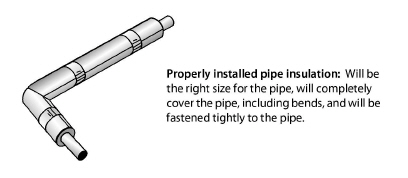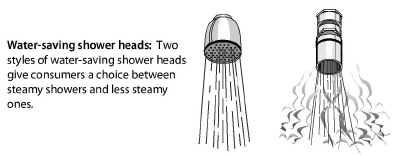
10.6 Water-Heating Energy Savings
For safety information on combustion water heaters, see “Spillage and CO Testing” on page 231.
The most important tasks in evaluating hot water energy savings are determining the water heater’s insulation level, measuring the shower’s flow rate, and measuring the water temperature.
|
Number of Residents |
Annual kWh |
Annual Therms |
Gallons Per Day |
|---|---|---|---|
|
1 |
2700 |
180 |
25 |
|
2 |
3500 |
230 |
40 |
|
3 |
4900 |
320 |
50 |
|
4 |
5400 |
350 |
65 |
|
5 |
6300 |
410 |
75 |
|
6 |
7000 |
750 |
85 |
|
Author’s interpretation of data from single-family homes with existing water heaters from Energy Information Administration, Lawrence Berkeley Laboratory, Home Energy Magazine, and others. |
|||
10.6.1 Water-Saving Shower Heads and Faucet Aerators
Most families use more hot water in the shower than for any other use. A low-flow shower head reduces this consumption.
ü Water-saving shower head must be rated for a flow of ≥2.5 gallons per minute.
ü Water-saving aerators must be rated for a flow of ≥2.2 gallons per minute.
ü Use caution in removing the existing shower head or aerator from old, fragile plumbing fixtures.
ü The shower or faucet flow rate must be satisfactory to the occupants and be documented.
ü Recycle replaced shower heads and aerators.

Measuring Shower or Faucet Flow Rate
You can determine flow rate by measuring the time needed to fill a one-gallon plastic container. If the one-gallon container fills in less than 20 seconds, your flow rate is more than 3 gallons per minute.
1. Start the shower and set it to the maximum showering rate.
2. Start a stopwatch at the same time you move the container underneath the shower, capturing its entire flow.
3. Record the number of seconds and divide 60 by that number to find gallons per minute.
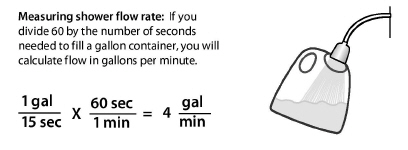
|
SWS Detail: 7.8102.2 Storage-Type Appliance, 7.8103.1 Storage-Type Appliance |
Install an R-11 insulation blanket on all water heaters that are outside the heated space, unless the manufacturer’s label prohibits it. Follow these guidelines to avoid fire hazards and to simplify future service.
Gas Water Heaters
When you install insulation on gas water heaters, use these specifications.
ü Keep insulation at least 2 inches away from the gas valve and the burner access panel. Don’t install insulation below the burner access panel.
ü Don’t cover the pressure relief valve or discharge line with insulation.
ü Don’t insulate the tops of gas-fired water heaters because the insulation can obstruct the draft diverter.
Electric Water Heaters
When you install insulation on electric water heaters, use these specifications.
ü Mark the blanket to locate the thermostat and heating element access plates or cut the blanket at these locations.
ü When you cut the blanket for the thermostats, cut the bottom and sides but not the top. This creates a hinge that allows the door in the insulation to swing open and closed.
ü Cover the top of the water heater with insulation.
ü Don’t cover the pressure relief valve and discharge line with insulation.
ü If you specify insulation for an existing water heater which has a relief valve but no discharge line, install a discharge line outside the insulation to within 6 inches of the floor.
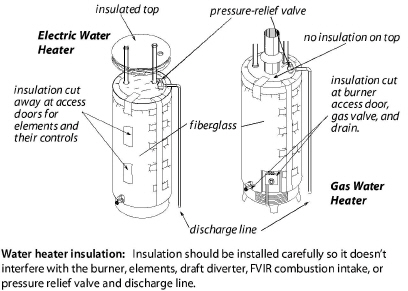
10.6.3 Measuring and Adjusting Hot Water Temperature
|
SWS Detail: 7.8103.1 Storage-Type Appliance, 7.8103.2 On-Demand Appliance |
Use the following instructions to adjust water temperature.
ü Shut off power to an electric water heater before opening thermostat access panels.
ü Measure the water temperature at the nearest faucet to the water heater. Reduce the temperature to 120° F with the customer’s permission.
ü On electric water heaters, set both upper and lower thermostats to the same temperature.
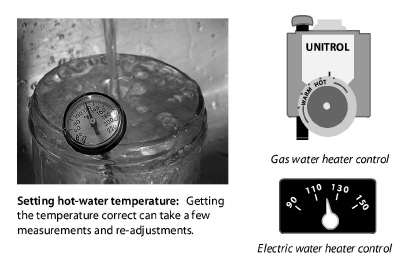
10.6.4 Heat Traps and Water-Heater Pipe Insulation
|
SWS Detail: 7.8103.1 Storage-Type Appliance, 7.8103.2 On-Demand Appliance |
Install heat traps if the water heater has no built-in heat traps. Heat traps are piping loops or valves that prevent thermo-siphoning of water in and out of the piping near the water heater.
Install pipe insulation to slow convection of hot water into the water lines near the tank.
ü Interior diameter of pipe sleeve must match exterior diameter of pipe
ü Insulate the first 6 feet of hot and cold water pipe from the water heater.
ü Use pipe wrap with a minimum thickness of 1 inch and a minimum R-value of 2. Cover elbows, unions and other fittings with the same insulation thickness as the pipe.
ü Corners must be mitered, tight fitting, sealed and secured with appropriate material to prevent failure.
ü Keep pipe insulation 6 inches away from single-wall vent pipe and 1 inch away from Type B vent.
ü Fasten pipe insulation with zip ties, tape, or other approved method.
